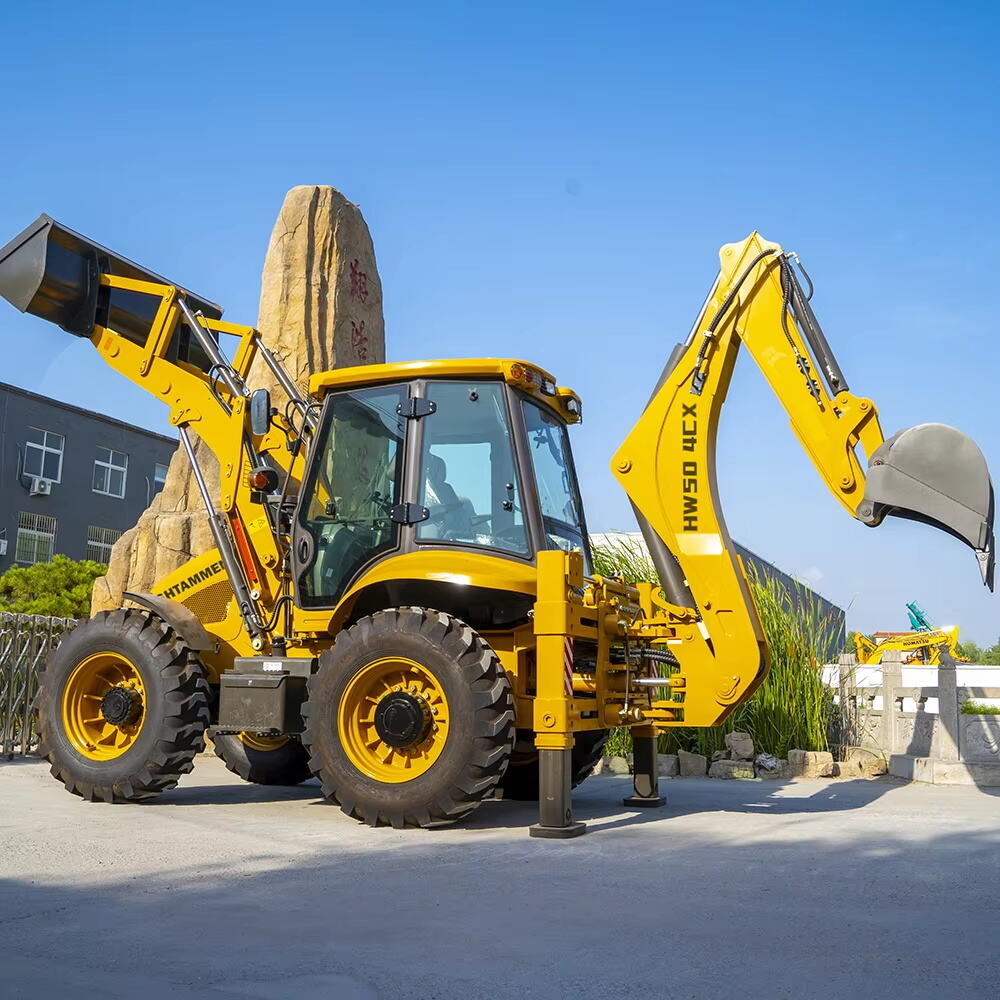다용도의 건설 장비를 언급할 때 굴삭기 로더는 백호로더 효율성과 생산성의 핵심으로 독보적인 위치를 차지합니다. 이 강력한 기계는 앞부분에는 로더의 기능을, 뒷부분에는 엑스케이버 스타일의 백호를 갖추고 있어 규모에 상관없이 모든 건설 프로젝트에 필수적인 도구로 자리매김하고 있습니다. 새로운 건물을 위한 착공 작업, 자재 운반, 유틸리티 설치 작업 등 어떤 프로젝트를 진행하든 올바른 백호 로더를 선택하는 것은 프로젝트 성공과 수익성에 큰 영향을 미칩니다.
오늘날의 건설 산업은 최고의 성능을 제공하면서도 비용 효율성과 신뢰성을 유지하는 장비를 요구합니다. 백호 로더는 다목적 솔루션으로서 현장에서 여러 전용 장비의 필요성을 효과적으로 줄여줍니다. 완벽한 백호 로더를 선택하는 방법을 이해하기 위해서는 기술 사양부터 실제 응용 분야까지 다양한 요소들을 신중하게 검토해야 합니다.

모든 백호 로더의 핵심은 엔진입니다. 최신 백호 로더는 일반적으로 70마력에서 110마력 사이의 엔진을 사용합니다. 이상적인 출력은 특정 용도와 작업 조건에 따라 달라집니다. 고출력 장비는 깊은 굴착이나 무거운 짐을 들어 올리는 것과 같은 까다로운 작업에 효과적이며, 저출력 장비는 가벼운 작업에 더 적합하고 연비가 더 좋습니다.
선택 시 엔진의 토크 특성과 배출가스 규제 준수 여부를 고려해야 합니다. 최신 엔진 관리 시스템과 배출가스 기술은 법적 규제를 준수할 뿐만 아니라 연료 효율 향상과 운영 비용 절감에도 기여합니다.
백호우 로더의 가장 중요한 사양 중 하나는 굴착 능력입니다. 표준 모델은 일반적으로 14~16피트의 굴착 깊이를 제공하는 반면, 긴 암 버전은 최대 20피트 깊이까지 도달할 수 있습니다. 보다 적절한 도달 거리와 깊이 사양을 결정하기 위해 귀하의 일반적인 프로젝트 요구사항을 평가해 주십시오.
로더 버킷 용량과 파기력(breakout force)도 동일하게 중요한 고려사항입니다. 이러한 사양은 기계가 재료 적재 및 운반 작업을 얼마나 효율적으로 수행할 수 있는지에 직접적인 영향을 미칩니다. 다양한 작업 환경에서 안전한 운용을 보장하기 위해 도달 능력과 안정성 사이의 균형을 갖춘 제품을 선택하시기 바랍니다.
유압 시스템은 백호우 로더의 전체 성능에 있어 매우 중요합니다. 최신 기종에는 가변 배기량 펌프와 부하 감지 기능을 갖춘 고급 유압 시스템이 적용되어 있습니다. 이러한 시스템은 동력 분배를 최적화하고 연료 효율성을 개선하며 로더와 백호우 기능 모두에 대해 부드럽고 정밀한 제어를 제공합니다.
유압 유량 및 작동 압력에 주의를 기울이십시오. 이러한 요소들은 기계의 사이클 시간과 전반적인 생산성에 영향을 미치기 때문입니다. 고성능 유압 장치는 반복 작업 중 사이클 시간을 크게 단축시키고 연료 효율성을 개선할 수 있습니다.
운전자의 편안함과 제어 접근성은 생산성에 직접적인 영향을 미칩니다. 최신 백호우 로더는 파일럿 제어 및 전통적인 기계식 시스템을 포함한 다양한 제어 방식을 제공합니다. 파일럿 제어는 보다 높은 정밀도와 운전자의 피로도 감소를 제공하는 반면, 기계식 제어는 경험이 많은 운전자에게는 친숙한 작동 방식을 제공합니다.
다양한 작업자 선호도에 맞출 수 있도록 조절 가능한 제어 패턴을 갖춘 장비를 고려하십시오. 복귀 굴착 기능 및 자동 붐 잠금과 같은 고급 기능은 작동 중 효율성과 안전성을 향상시킬 수 있습니다.
장비의 가동 시간과 수명을 극대화하려면 정기적인 유지보수가 필수적입니다. 정비 포인트에 접근이 용이하고 지상 수준에서 정비가 가능한 바크호 로더를 선택하십시오. 일상 점검 및 정기 정비 절차는 간단하고 시간 효율적이어야 합니다.
긴 간격의 정비 주기는 운영 비용을 크게 절감하고 장비 가용성을 향상시킬 수 있습니다. 최신 바크호 로더는 종종 실시간 유지보수 경고 및 진단 정보를 제공하는 고급 모니터링 시스템을 탑재하고 있습니다.
대체 부품의 가용성과 신뢰할 수 있는 딜러 지원은 다운타임을 최소화하는 데 매우 중요합니다. 확장된 딜러 네트워크와 검증된 부품 유통 시스템을 갖춘 제조사들을 선택하세요. 구매 결정 시 현지 딜러의 위치와 평판을 고려해야 합니다.
제조사의 보증 범위 및 이용 가능한 서비스 계약을 평가해 보세요. 이러한 요소는 장기적인 소유 비용과 장비 신뢰성에 상당한 영향을 미칠 수 있습니다.
최신 백호 로더는 점점 더 발전된 원격 통신 시스템을 탑재하여 차량 관리를 개선하고 있습니다. 이러한 시스템은 장비 사용률, 연료 소비량, 정비 요구사항에 대한 유용한 데이터를 제공합니다. 운영 및 정비 일정 최적화를 위해 내장형 원격 통신 기능이 있는 장비를 고려해 보세요.
원격 모니터링 기능 및 기존 운송 관리 시스템과의 통합이 가능한 장비를 선택하십시오. 이러한 기능은 전체 차량 운영 효율성을 개선하고 운영 비용을 절감하는 데 도움이 될 수 있습니다.
현대 건설 장비에서는 안전 기능과 자동화 기능이 지속적으로 발전하고 있습니다. 백업 카메라, 물체 감지, 안정성 제어 등 첨단 안전 시스템이 장착된 백호 로더를 고려하십시오. 이러한 기능은 작업자 안전을 향상시키는 동시에 작업장 효율성도 개선합니다.
되감기 기능 및 붐 높이 제한과 같은 자동 기능은 작업자의 피로도를 줄이면서 생산성을 높일 수 있습니다. 특정 작업 요구 사항과 작업자 숙련도에 따라 사용 가능한 기술 옵션을 평가하십시오.
최적의 크기는 귀하의 특정 작업 조건에 따라 다릅니다. 일반적인 굴착 깊이, 작업물 처리 요구 사항 및 작업 현장 접근 조건 등을 고려하십시오. 중형 기계(14~15피트 굴착 깊이)는 일반 건설 작업에 가장 다양하게 활용할 수 있으며, 보다 깊은 굴착이나 무거운 적재 작업에는 더 큰 모델이 필요할 수 있습니다.
운용 비용은 연료 효율성, 정비 요구 사항 및 초기 구매 가격과 같은 요소에 따라 달라집니다. 최신 기종의 경우, 발전된 엔진 관리 및 유압 시스템을 통해 일반적으로 연료 효율성이 우수합니다. 모델 비교 시 유지보수 비용, 부품 확보 가능성 및 재판매 가치를 포함한 총 보유 비용을 고려해야 합니다.
조종식 및 기계식 컨트롤 중 어떤 것을 선택할지는 종종 작업자의 선호도와 적용 조건에 따라 결정됩니다. 조종식 컨트롤은 보다 정밀한 조작이 가능하고 작업 피로도를 줄여주지만 추가적인 교육이 필요할 수 있습니다. 기계식 컨트롤은 경험이 많은 작업자에게 익숙하며 혹독한 환경에서도 더 견고할 수 있습니다. 최대한의 유연성을 위해 컨트롤 패턴을 전환할 수 있는 장비를 고려하십시오.
 핫 뉴스
핫 뉴스2024-10-31
2024-10-28
2024-10-25
2024-10-23
2024-10-21
2024-09-03